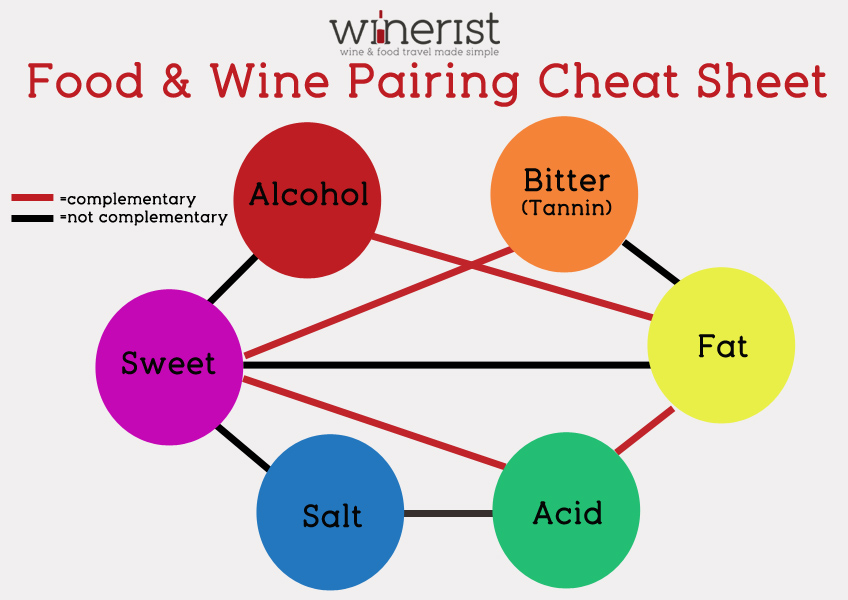When it comes to food and wine pairing, the first thing you need to know is that food changes the way the wine tastes and vice versa. If you’re not careful, you can create undesirable reactions through the wrong pairings, but if you pair correctly, then you open a new world of flavour.
Crucially, you need to understand the fact that different people have different sensitivities when it comes to identifying aromas and flavours. Some may desire a strong reaction to tartness for example, whereas some may not. Always take into account the preferences of who you are serving for, combine that knowledge with the general rules to food and wine pairing and you’ll be golden.
FLAVOURS & TEXTURES
Sweetness: High sugar content in your meal will make a wine taste more bitter and acidic, and lose its fruity flavours. Think of it as when you eat cake and it just completely covers the inside of your mouth: your taste buds become impaired. This is what we call making the wine taste harder. Select a wine with a higher level of sweetness (or at least as much sugar) than the dish so the flavours complement each other instead of fighting against each other. A sweet wine with a good level of acidity like Sauternes will also match rich foods such as foie gras.
Umami (savoury): This is not a primary taste, but it is generally found in most dishes. Think mushrooms or just taste some MSG. It’s an earthy flavour that is extremely difficult to pair with wine because of the varying salt levels different meals contain. High umami content without a high salt level makes the wine harder, so go for a sweet or off-dry wine like Muscadet.
High umami content with a high salt level has the opposite effect, so go for a more acidic wine. Umami generally makes the wine more acidic, gives it more of a burn, and loses some of the fruitiness (similar to how the sugar content reacts). So go for a wine that has plenty of fruit whilst differing the levels of acidity and sweetness depending on the salt level.
Because of its earthy flavour, you want to find a wine that compliments that, so what I recommend is baking Portobello mushrooms stuffed with Boursin (garlic cheese) and have it with a Pinot Noir. The earthiness from the mushroom matches the earthiness you get in the Pinot Noir, and the garlic in the cheese is quite a woody flavour, so it naturally pairs. Don’t worry, that’s the most complicated one out the way.
Salt: Salt gives the wine more body whilst reducing the acidity levels, it’s pretty wine friendly to be honest. The classic one to remember is seafood in this instance. Go for a nice crisp white, a pristine Pinot Grigio perhaps.
However, avoid pairing a great, big spicy shiraz from Australia with a beautiful, delicate piece of seabass -this will knock it for six. If you want red with your seafood, make a fisherman’s stew, reduce it and add flavours which will combat the fishes natural salty flavours (your woody herbs such as rosemary for example).
Acidity: The opposite to sweetness in every way – in food this is things like lemon juice. It takes away some of the wine’s acidity whilst increasing its fruitiness and body. You just need to get the balance right for this one. For highly acidic foods go for a wine with a highly acidic flavour, and vice versa. If you had a wine that was low in acidity with a meal that was high in acidity, the wine would feel flabby and sad. When drinking highly acidic wines you want it to cleanse the pallet, so whites such as Sauvignon Blanc and Pinot Grigio are good ones to start with and they work extremely well when paired with oily foods. Italian reds too have a high level of acidity, such as Montepulciano and Chianti, and work well with heavy oily meals.
Try to match the weight of the meal with the weight of the wine too, so oily fish such as smoked salmon work better with whites and Champagne, and heavy oily dishes such as lasagne work better with reds that have a good level of acidity.

Spice: Of course everyone tolerance threshold is different when it comes to spice (always taste your chillies before you cook with them to test the heat). Some people enjoy the heat, some don’t. A thing to remember is that the higher the alcohol content, the more intense the heat sensation becomes and vice versa.
If you enjoy this, get a 15% red in. If you don’t then it’s just trial and error until you find the right alcohol content that matches your pallet. A good example of a solid wine choice for spicy food is either a Sauvignon Blanc, due its acidic flavours lifting the spices (think lime juice on a curry) or a Viognier, which is aromatic and compliments spices such as lemongrass and cumin. If you want red, go light and go Beaujolais. Avoid heavy oak flavours here as they can overpower the spices, so just look on the back of the bottle and if it says it has been aged in oak barrels for a long time then put it back on the shelf. To start you off, stay away from Rioja.
Bitterness: Foods that are naturally bitter tend to increase a wines bitterness as well. Again, this does change from person to person. So again it’s more trial and error with this one because your meal could have a nice underlying level of bitterness that you would think combines well with something like a Cabernet Sauvignon, only for the bitterness to overpower your pallet.
Tannins add to a wine’s bitter flavour and acidity making it drier and bite the gums. They are more commonly found in red wines and the odd white depending on what it has been aged in. Tannins naturally occur in wood as well as fruit skins and leaves. For example and oak aged wine will tend to have a higher tannic level. Try eating dark chocolate, and I mean dark, at least 85%, and pair it with a Rioja. This will judge your bitter tolerance in a fun way. Then, if it’s too much, work your way down and try a wine that is less tannic. As a general rule, the more textured or fatty the meal, the more tannin you need. Steak with a Cabernet Sauvignon or a Malbec is a good example here.
TRY IT AT HOME
Sweet and savoury: Pancakes with bacon. Sugar and salt. Together it works. The same applies with wine. Take a food that is high in salt, a stinky blue cheese for example, and pair it with a sweet wine such as port, you get the sweet and savoury sensation. I wouldn’t call this an anomaly because it varies from pallet to pallet, it’s just a pleasurable experience. So don’t forget to try that at some point.
In fatty foods, and I’m not talking about fast food here, you want a wine that either matches the big flavours, or you want to “cut through” it. Try a big hearty stew with a Riesling that is crisp with a slight residual sweetness and it’s like taking your mouth to the car wash. Cleans it right up and lets you enjoy each mouthful as if it were the first.
Make sure you use our wine pairing chart next time you’re trying to find complentary flavours
